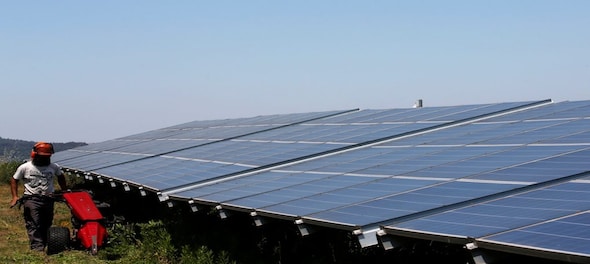
India is targeting to achieve 450 gigawatt (GW) of renewable energy installed capacity by 2030, while the current capacity stands at 105.8 GW. Installed capacity is the amount of energy that a power station can produce.
Over the past year, major players, both private and public, have announced ambitious energy transition plans.
In line with India’s commitment, the government recently hiked the budget expenditure of state-run Indian Renewable Energy Development Agency (IREDA) and Solar Energy Corporation of India (SECI) collectively by 143 per cent at Rs 28,570.99 crore.
The Centre has also established a ‘society’ under the Ministry of Power that aims to serve as the primary policy advocacy arm for the power and related sectors, assisting states and industries with energy transformation.
Major Central Public Sector Enterprises (CPSEs) such as NTPC, Powergrid, REC, PFC, NHPC, THDC, NEEPCO, and SJVN have registered with the Power Foundation under the Societies Act, under the Power Ministry.
Some of these PSUs have also committed to accelerating the transition. Without their cooperation, the ambitious targets simply cannot be met.
Here are top PSUs of the power sector in India that can impact the transition to clean energy.
National Thermal Power Corporation Limited (NTPC)
NTPC is India’s largest power utility with an installed capacity of 68.5 GW, accounting for about 16.78 percent of India’s total national capacity and 20.96 percent of total power generation as of March 2020, according to a Mongabay report. NTPC aims to become a 130-GW company by 2032. It also expects to have a minimum 32,000MW capacity through renewable sources, constituting nearly 25 percent of its overall power output. This includes 30GW of solar capacity.
The company has 24 coal-based projects, 7 gas-based, 13 solar, and one each of hydro, wind, and small-hydro projects.
According to a Saur Energy International report, NTPC has 2,298 MW of renewable energy projects which are under implementation. This includes 237 MW from floating solar projects located in reservoirs utilised in NTPC’s existing stations. Ramagundam 100 MW Floating Solar is the largest in the country.
NTPC also has existing assets that can be repurposed for the generation of green energy.
For instance, the International Forum for Environment, Sustainability and Technology (iForest), a think-tank, said that companies like NTPC can repurpose their land assets such as at Korba, which is India’s biggest coal-producing district, to implement renewable energy projects, as reported by Mongabay.
National Hydroelectric Power Corporation (NHPC)
NHPC is the largest organisation for hydropower development in India with a base of almost 7 GW from 24 power projects. NHPC Limited has diversified in the field of solar and wind power to further the energy transition agenda of the country.
NHPC has signed an MoU with Green Energy Development Corporation of Odisha Limited (GEDCOL) under which they will form a joint venture company for the development of techno-commercially feasible floating solar power projects of 500 MW in Odisha.
NHPC has devised one of the most ambitious plans for solar plants in the country, aiming for a 1 GW plus target, in states including Odisha and Telangana. Additionally, it has received approvals for over 250 MW of solar projects.
NLC India Ltd
NLC India Ltd is a public sector company engaged in mining and power generation. Its current renewable energy capacity is 1.4 GW which is amongst the highest for all CPSE’s, as per the Saur Energy International report.
NLC has registered for new initiatives in green energy sector and formed a joint venture company with Coal India Limited to develop solar and thermal power assets. Currently, the company has 2.8GW of solar and wind projects in the pipeline to be completed by 2025. With this, the PSU can make a significant impact on the transition to clean energy.
Coal India Limited (CIL)
CIL is a state-owned coal mining corporate and the largest coal producer in the world. The company is eyeing long-term expansion as it seeks to build a renewables portfolio.
CIL had announced an investment plan of about Rs 58 billion by 2024 for the development of 3GW solar power projects. In April 2021, CIL established two wholly-owned subsidiaries, Solar PV Limited and CIL Navikarniya Urja Ltd for manufacturing solar value chain products and undertaking renewable energy projects. CIL also announced plans to establish a 4GW solar PV module manufacturing plant to further support its agenda of clean energy expansion.
These large PSUs have a bigger role to play in the transition of energy. Apart from installing renewable projects, the PSUs have vast amounts of land assets that can be used for the implementation of renewable projects.
For instance, repairing of mines and repurposing its existing infrastructure and land assets in the mine area are important for CIL to invest in green energy.
Similarly, NTPC has the Korba district that can be utilised to diversify the company’s green investment portfolio through the implementation of renewable energy projects there, according to iForest, as reported by Mongabay.
(Edited by : Thomas Abraham)
Check out our in-depth Market Coverage, Business News & get real-time Stock Market Updates on CNBC-TV18. Also, Watch our channels CNBC-TV18, CNBC Awaaz and CNBC Bajar Live on-the-go!


BJP holds meeting in Delhi as polling underway for 5th phase
May 20, 2024 4:21 PM
UP Police arrests man after viral videos shows him voting multiple times
May 20, 2024 2:18 PM

